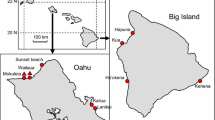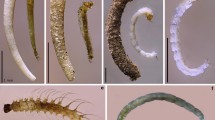Abstract
A nine-year study at a moderately exposed, fine sand intertidal beach at Long Sands, Maine, USA identified marked seasonal changes in the foci of sand-burrowing amphipod activities. These included seasonal population movements, degree of interspecific horizontal overlap, life stage segregation within and between species, and sand depth stratification. Behavioral interactions related to competition for available space are considered important in affecting the distribution and abundance of amphipod species, and community structure. Significant negative correlations were shown between the abundance and upper distributional limits of the smaller, lower shore Acanthohaustorius millsi and the abundance of the larger, higher shore species Haustorius canadensis. Tolerance limits to a variety of prevailing physical factors alone, were not considered a serious obstacle to occupation of higher intertidal level sands by A. millsi. Summer brooding females of both species occupied similar 5 to 10 cm sand depths, but were strongly segregated horizontally. Laboratory coexistence experiments during the reproductive period showed increased mortality of adults and negligible reproductive output of A. millsi when in combination with H. canadensis compared to controls where the former species was alone. A third species, Amphiporeia virginiana, occupied primarily very shallow sand (0 to 2.5 cm), and performed seasonal movements opposite in direction to A. millsi and H. canadensis. The presence, amount, and refinement of biological interactions across the wave exposure gradient requires further study. Until then, we consider as inappropriate the blanket designation of all types of intertidal sand communities as “physically controlled”.
Similar content being viewed by others
Literature Cited
Bosworth, W. S., Jr.: Biology of the genus Eohaustorius (Amphipoda: Haustoriidae) on the Oregon coast. 194 pp. Ph.D. Thesis, Oregon St. Univ., Corvallis, 1977
Bousfield, E. L.: Adaptive radiation in sand-burrowing amphipod crustaceans. Chesapeake Sci. 11, 143–154 (1970)
Bousfield, E. L.: Shallow-water gammaridean Amphipoda of New England. 312 pp. Cornell Univ. Press., Ithaca, N. Y. 1973
bousfield, E. L.: A revised classification and phylogeny of amphipod crustaceans. Trans. R. Soc. Can. 16, 343–390 (1978)
Colman, J. S. and F. Segrove: The fauna living in Stoupe Beck Sands, Robin Hood's Bay (Yorkshire, North Riding). J. Anim. Ecol. 24, 426–444 (1955)
Connell, J. H.: The influence of interspecific competition and other factors on the distribution of the barnacle Chthamalus stellatus. Ecology 42, 710–723 (1961)
Croker, R. A.: Niche diversity in five species of intertidal amphipods (Crustacea: Haustoriidae). Ecol. Monogr. 37, 173–200 (1967)
Croker, R. A.: Macro-infauna of northern New England marine sand: Long-term intertidal community structure. In: Ecology of marine benthos, Vol. 6, pp 439–450, Ed. by B. C. Coull. Belle W. Baruch Library in Marine Science, Columbia, S. C.: Univ. of South Carolina Press 1977
Croker, R. A., R. P. Hager and K. J. Scott: Macroinfauna of northern New England marine sand. II. Amphipod-dominated intertidal communities. Can. J. Zool. 53, 42–51 (1975)
Dahl, E.: Some aspects of the ecology and zonation of the fauna on sandy beaches. Oikos 4, 1–27 (1952)
Dexter, D. M.: Population dynamics of the sandy-beach amphipod Neohaustorius schmitzi Bousfield. 105 pp. Ph.D. Thesis, Univ. of North Carolina, Chapel Hill, 1967
Dexter, D. M.: Structure of an intertidal sandy-beach community in North Carolina. Chesapeake Sci. 10, 93–98 (1969)
Edwards, R. and J. H. Steele: The ecology of O-group plaice and common dabs at Loch Ewe I. Population and food. J. exp. mar. Biol. Ecol. 2, 215–238 (1968)
Elton, C. S. and R. S. Miller: The ecological survey of animal communities: With a practical system of classifying habitats by structural characters. J. Ecol. 42, 460–490 (1954)
Fincham, F. A.: Amphipods in the surf plankton. J. mar. biol. Ass. U.K. 50, 177–198 (1970)
Fincham, A. A.: Ecology and population studies of some intertidal and sublittoral sand-dwelling amphipods. J. mar. biol. Ass. U.K. 51, 471–488 (1971)
Gibson, R. N.: The biology and behaviour of littoral fish. Oceanogr. Mar. Biol. Ann. Rev. 7, 367–410 (1969)
Gibson, R. N.: The intertidal movements and distribution of young fish on a sandy beach with special reference to the plaice (Pleuronectes platessa L.) J. exp. mar. Biol. Ecol. 12, 79–102 (1973)
Hager, R. P. and R. A. Croker: Macroinfauna of northern New England marine sand. IV. In: faunal ecology of Amphiporeia virginiana Shoemaker, 1933 (Crustacea: Amphipoda). Can. J. Zool. 57, 1511–1519 (1979)
Hager, R. P. and R. A. Croker: The sand-burrowing amphipod, Amphiporeia virginiana Shoemaker 1933 in the tidal plankton. Can. J. Zool. 58, 860–864 (1980)
Holland, A. F. and J. M. Dean: The community biology of intertidal macrofauna inhabiting sandbars in the North Inlet area of South Carolina, U.S.A. In: Ecology of marine benthos, Vol. 6, pp. 423–438, Ed. by B. C. Coull. Belle W. Baruch Library in Marine Science, Columbia, S.C.: Univ. of South Carolina Press 1977
Holland, A. F. and T. T. Polgar: Seasonal changes in the structure of an intertidal community. Mar. Biol. 37, 341–348 (1976)
McIntyre, A. D.: The range of biomass in intertidal sand, with special reference to the bivalve, Tellina tenuis. J. mar. biol. Ass. U.K. 50, 561–575 (1970)
Menge, B. A. and J. P. Sutherland: Species diversity gradients: Synthesis of the roles of predation, competition, and temporal heterogeneity. Am. Nat. 110, 351–369 (1976)
Nicolaisen, W. and E. Kanneworff: On the burrowing and feeding habits of the amphipods Bathyporeia pilosa Lindstrom and Bathyporeia sarsi Watkin. Ophelia 6, 231–250 (1960)
Puttick, G. M.: Spatial and temporal variations in the intertidal animal distribution at Langebaan Lagoon, South Africa. Trans. R. Soc. S. Afr. 42, 403–440 (1977)
Puttick, G. M.: The diet of the curlew sandpiper at Langebaan Lagoon, South Africa. Ostrich 49, 158–167 (1978)
Salvat, B.: La macrofaune carcinologique endogee des sediments meubles intertidaux (Tanaidacés, Isopodes et Amphipodes), éthologie, bionomie et cycle biologique. Mém. Mus. natn. Hist. nat. (Paris) Ser. A, Zool. 45, 1–275 (1967)
Sameoto, D. D.: Comparative ecology, life histories and behavior of intertidal sand burrowing amphipods (Crustacea: Haustoriidae) at Cape Cod. J. Fish. Res. Bd Can. 26, 361–388 (1969a)
Sameto, D. D.: Physiological tolerances and behaviour responses in five species of Haustoriidae (Amphipoda: Crustacea) to five environmental factors. J. Fish. Res. Bd Can. 26, 2283–2295 (1969b)
Sanders, H. L.: Marine benthic diversity: A comparative study. Am. Nat. 102, 243–282 (1968)
Sanders, H. L.: Bentic marine diversity and the stability-time hypothesis. Brookhaven Symp. Biol. 22, 71–81 (1969)
Thijssen, R., A. J. Lever, and J. Lever: Food composition and feeding periodicity of O-group plaice (Pleuronectes platessa) in the tidal area of a sandy beach. Neth. J. Sea Res. 8, 369–374 (1974)
Tyler, A. V.: Surges of the winter flounder, Pseudopleuronectes americana, into the intertidal zone. J. Fish. Res. Bd Can. 28, 1727–1732 (1971)
Watkin, E. E.: The macrofauna of the intertidal sand of Kames Bay, Millport, Buteshire. Trans. R. Soc. Edinb. 60, 543–561 (1942)
Woodin, S. A.: Refuges, disturbance, and community structure: a marine soft-bottom example. Ecology 59, 274–284 (1978)
Author information
Authors and Affiliations
Additional information
Communicated by I. Morris, West Bothbay Harbor
Rights and permissions
About this article
Cite this article
Croker, R.A., Hatfield, E.B. Space partitioning and interactions in an intertidal sand-burrowing amphipod guild. Mar. Biol. 61, 79–88 (1980). https://doi.org/10.1007/BF00410343
Accepted:
Issue Date:
DOI: https://doi.org/10.1007/BF00410343




